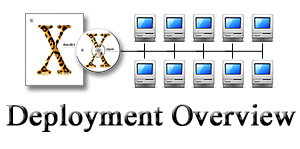Deployment Overview
By: Mikio Moriyasu - Revised: 2006-08-03 devin
Introduction
An overview of the primary issues related to OS X deployment and maintenance.Section Links
Primary Issues
Widespread deployment of OS X in all labs depends on the following factors:- Overall availability and reliability of deployment/maintenance tools.
- Overall ease of use of deployment/maintenance tools.
- User and staff demand.
- General patron acceptance of the OS X environment
- Availability of native software.
- Availability of updates to OS X that make it easier to incorporate into a lab environment.
Maintenance
Ideally, we want OS X maintenance tools to provide the same degree of friendliness, functionality, and reliability we currently have in applications that we use to maintain labs in our Mac OS 9.x environment.Currently, we use RevRdist with AppleScript and other miscellaneous utilities to deploy and support Mac OS 9.2.2. This allows us to perform automated initial setup, distribute software, and hard disk maintenance on some 400 Macs in multiple locations across the University of Utah campus. We can quickly and easily upgrade or downgrade software as well as the Mac OS, and have it distributed the next day on all the machines.
This setup also allows users to install and save software on the local hard drives. The RevRdist based hard disk maintenance protocol is designed to run nightly to will remove any changes or additions to the critical portions of the operating system such as the System Folder or the Applications folder. As a result of this process, installed applications are removed, but users files remain intact and are moved to a global "Lost & Found" folder for safe keeping.
A similar maintenance protocol must be available for Mac OS X before it can be widely deployed.
User Friendliness
Students, faculty, and staff should be confident that any OS X machines that are supported by Student Computing Labs will offer comparable levels of functionality and user friendliness that they already have in the existing Mac OS 9.x environment. This confidence will help us gain user acceptance of and perhaps even generate demand for OS X.One key factor in this is the availability of native software. Currently, there are over 300 different applications in the OS 9.x environment. While we don't expect all of them to be ported over to OSX, a sufficient number of the most widely used ones must be available to satisfy the patrons' needs before OS X can be confidently deployed.
On a related note, a number of the machines are equipped with frequently used third-party peripheral devices. These are largely comprised of external disk drives, scanners, and video editing equipment. Before any extensive OS X deployment Student Computing Labs must be reasonably assured that either Apple or the device manufacturers will provide OS X compatible drivers so that they operate.
Another critical factor is Student Computing Labs' University related instructional support services. With machines in over a dozen multimedia rooms, teaching labs, and offices to maintain, the speed and degree of the OS X deployment will depend on the impact its use in these facilities will have on faculty and staff. We need to be confident that widely used applications, as well as those used for specific purposes can be quickly and easily installed, and will work efficiently in the Mac OS X environments.
Additional Information
The University of Utah is one of 20 participating institutions of the Higher Education Mac OS X Lab Deployment Initiative. These institutions, which span the world, are establishing pilot labs running Mac OS X. The primary goal of the project is to simplify the task of installing & maintaining Mac OS X in an academic lab environment by providing a "road map" for others to follow as they plan to roll out Mac OS X at their respective institutions.
Introduced at the January 2002 MacWorld Conference and Expo, macosxlabs.org is the new web site for the initiative. While the site serves as the primary means of communication and collaboration for the 20 lab administrators working on the project, it will also be used to publish the information gathered by the project. In this way, interested individuals will be able to stay up-to-date on issues, problems, and solutions related to the deployment of OS X. The site already features extensive documentation on deployment issues, tools & utilities, a public discussion forums and resources.
For additional information please click here to visit www.macosxlabs.org.
- Documentation
- Administration
- Authentication
- General Software
- Hardware
- Miscellaneous
- Multimedia
- Networking
- Operating Systems
- Outside Presentations
- Programming & Scripting
- Security
- Servers
- Short Courses
- System Deployment
- System Utilities
- What's New

